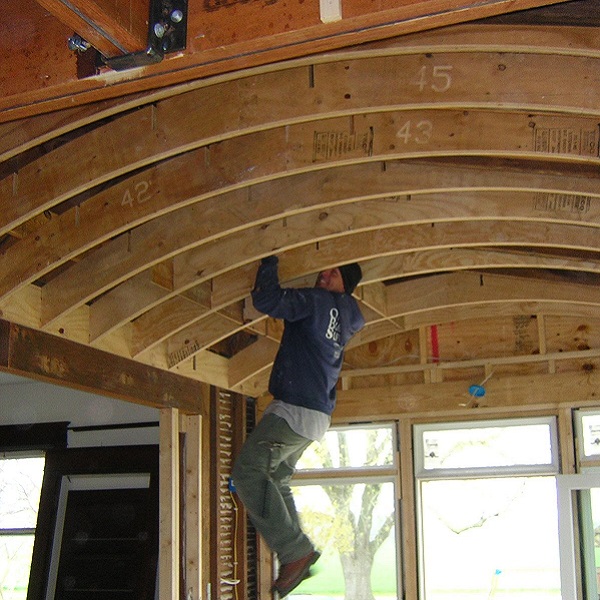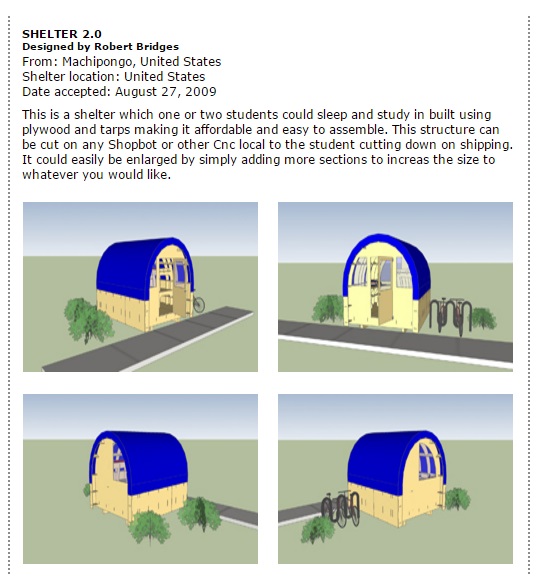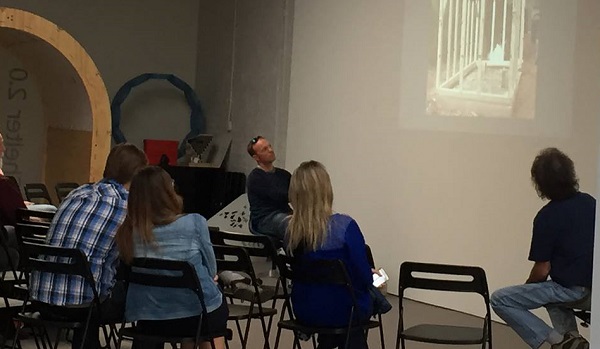I’ve been making things with ShopBots and sharing designs for ShopBot projects since the early days, almost 20 years ago. There have been boats, furniture, and design tools like Open Source Joinery, but the thing I’m most proud of is a side project, Shelter 2.0, that I work on with my friend and collaborator Robert Bridges. Robert and I have known each other for years and have collaborated on all kind of design and fabrication projects. This slideshow shows some of the things we’ve worked on together:
One trait Robert and I share is a pretty strong drive to help folks, and the Shelter 2.0 project grew out of that desire. It evolved from a design Robert entered in a contest hosted by the Guggenheim Museum and SketchUp that was inspired by a barreled ceiling that we had worked on.
We were both impressed with the inherent strength and aesthetic appeal of that rounded shape, and since with a CNC machine it’s just as easy to cut a curve as a straight line, Robert designed a structure that used the same curved form.
Robert didn’t win the contest, but we both liked the concept well enough that we decided to build one next to my shop to see what the space was really like. We were pretty pleased with this first prototype and decided that we would share the files as an Open Design project, so that others can build the same–or similar–structures. Though originally conceived as an option for transitional housing in emergency situations, the Shelter 2.0 design has as been used as housing for the homeless, as team-building projects in schools, and as a possible option in refugee housing. So far we know of 30 or more that have been built, and every week or so we see pictures of ones that we didn’t know about.
We’ve learned a lot over the years about sharing projects, and our designs have evolved as we have. Here are a couple of principles that have guided the modifications and changes we’ve made:
- Make it easy to duplicate. Not only with documentation, but also with design details. No matter how precise your tools are, it’s hard to design for and cut something out of an imprecise material. Rather than having to constantly modify files and models, we’ve worked on construction methods that are as close as we can get to being material agnostic.
- Share in helpful formats. We share in several formats so that folks can use them no matter what software they use. Our go-to design and toolpathing software is VCarve Pro so we include files in that format, but also include .dxf files which is a pretty universal format for CAD software. We like to supply documentation using Google docs or other web-based formats.
- Make sure it serves the need. Keeping costs down can certainly be important, but not at the expense of solving the problem at hand. After 5 years, there are still people living in tents after the Earthquake in Haiti, and the average length of stay in the larger refugee camps is 17 years. People need more than just a cheap and temporary “shelter”—it might be their home for quite a while.
- Encourage others to explore options in housing—building design shouldn’t be limited to architects! We feel like this design has a lot of things going for it, but it’s not by any means the only solution, or the best solution in every case. We hope though that by promoting it and keeping the conversation going that we’ll encourage others to come up with innovative solutions to all kinds of problems and needs.
- Explore options in design, materials, and construction. Although much of what we do these days involves digital tools, we both have a pretty strong foundation of analog skills… me as a boat carpenter and Robert as a carpenter and contractor. In many cases cutting everything with CNC machines makes a lot of sense, but we’ve also explored creating precise CNC-cut templates that can be duplicated on-site with traditional hand and power tools. This combination of digital and analog skills shows a lot of promise for areas that have limited infrastructure and skills, but lots of excess labor.
Recently we were invited to give a presentation about the Shelter 2.0 project at the DC FabLab, to share these ideas with community leaders interested in exploring solutions to DC’s housing problems. Many thanks to Phyllis and Alex for helping us spread the word about Shelter 2.0!
You can read more about the Shelter 2.0 project on our website and find files on Github at https://github.com/wlyoung/Shelter20 (files for a new 8’x8′ version will be uploaded soon, so stay tuned). We encourage you to look around for similar projects that you might want to get involved with, and we’re particularly excited about a new project, globalhumanitarianlab.org, that was founded by our friend David Ott from the International Red Cross.



